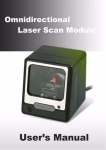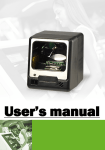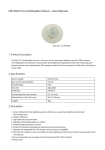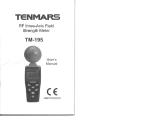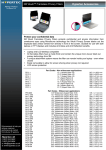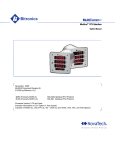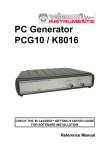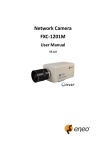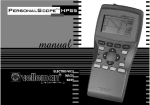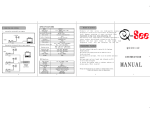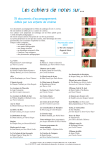Download User`s Manual
Transcript
User’s Manual OMNI-652 series Omni-Directional Laser Scanner Specifications subject to change without notice Radio Notice This equipment generates, uses and can radiate radio frequency energy. If not installed and used in accordance with the instructions in this manual, it may cause interference to radio communications. The equipment has been tested and found to comply with the limits for a Class A computing device pursuant to EN55022 an 47 CFR, Part 2 and Part 15 of the FCC Rules. These specifications are designed to provide reasonable protection against interference when operated in a commercial environment. Radio and Television Interference Operation of this equipment in a residential area can cause interference to radio or television reception. This can be determined by turning the equipment off and on. The user is encouraged to try to correct the interference by one or more of the following measures: **Re-orient the receiving antenna. **Relocate the device with respect to the receiver. **Move the device away from the receiver. **Plug the device into a different outlet so that the device and the receiver are on different branch circuits. If necessary the user may consult the manufacturer, an authorized dealer, or experienced radio/television technician for additional suggestions. The user may find the following booklet prepared by the Federal Communications Commission helpful: “How to Identify and Resolve Radio-TV Interference Problems.” This booklet is available from the U.S. Government Printing Office, Washington, DC20402 U.S.A., Stock No. 004000003454. For CE-countries This scanner is in conformity with CE standards. Please note that an approved, CE-marked power supply unit should be used in order to maintain CE conformance. Laser Safety The Omnidirectional Laser Scan Module complies with safety standard IEC 60825 for a Class I laser product. It also complies with CDRH as applicable to a Class IIa laser product. Avoid long term staring into direct laser light. Radiant Energy: The Omnidirectional Laser Scan Module uses one low-power visible laser diode operating at 650nm in an optomechanical scanner resulting in less than 3.9uW radiated power as observed through a 7mm aperture and averaged over 10 seconds. Do not attempt to remove the protective housing of the scanner, as unscanned laser light with a peak output up to 0.8mW would be accessible inside. Laser Light Viewing: The scan window is the only aperture through which laser light may be observed from this product. A failure of the scanner motor, while the laser diode continues to emit a laser beam, may cause emission levels to exceed those for safe operation. The scanner has safeguards to prevent this occurrence, If, however, a stationary laser beam is emitted, the failing scanner should be disconnected from its power source immediately. Adjustments: Do not attempt any adjustments or alteration of this product. Do not remove the protective housing of the scanner. There are no user-serviceable parts inside. Caution: Use of controls or adjustments or performance of procedures other than those specified herein may result in hazardous laser light exposure. Optical: The use of optical instruments with this product will increase the eye hazard. Optical instruments include binoculars, magnifying glasses, and microscopes but do not include normal eye glasses worn by the user. Table of Contents 1. General Information 2. Quick Start 2.1) Unpacking & Parts Identification 2.2) Power and Verifying Scanner Operation 2.3) Connecting to the host 3. Operation and Indicators 3.1) Operation 3.2) Indicators 4. Specifications 4.1) Controlling the Scanner from a Host System 4.2) Specifications 1. General Information Main Features The Omni directional Laser Scan Module is an easy-to-intergrate unit that performs 5 directions of scan field with a 20line scan pattern cycling at 1200 scan per second for quick accurate reads. The scanner’s smart small cubic design allows for easy integration into new equipment and efficiently reduces overall equipment size. Multiple interfaces include keyboard wedge, USB1.1, RS-232. 2. Quick Start 2.1) Unpacking & Parts Identification Unpacking: Omni-652 Unit x 1 User’s Manual x 1 (On CD) Programming Guide x 1 5V Adaptor (optional) x 1 Parts Identification: Scan Window LED Indicator Buzzer Optical Wake-up Sensor 2.2) Power and Verifying Scanner Operation Power: The scanner needs a minimum of 200mA at 5V power. The power link interface cable that comes with the scanner supports both direct power (where the scanner takes power from the host machine) and external power (the power adapter that’s plugged into an AC outlet). If the host machine supplies power, it must be the same as the input power specified (200mA @ 5V). When external power is used, the scanner does not take power from the host machine. There is no on/off switch on the scanner. It turns on when power is connected and turns off when power is removed. It is advised to turn off your POS or host system before installing the scanner to avoid electronic damage to your computer. Make sure to use only AC/DC power adaptor approved for the scanner. The usage of other power supplies may cause damage to the product that’s not covered by factory warranty. Verifying Scanner Operation: Before installing the scanner, follow the procedures below to make sure scanning go on properly. 1. Connect the scanner with host through cable that is attached to the scanner. 2. (If adaptor is not required, go directly to step 4) Insert the 8-pin modular plug of the power link cable into the “host” connector in the back of the scanner until a firm click is heard. 3. Plug the power adaptor into the jack on the power link cable. 4. When the scanner powers up, LED light up in green and the buzzer makes four short beep sounds. When the self-test is finished the LED light will turn red. 5. Place the "test barcode" in front of the scanner. If the scanner works right, it will make a short beep sound, and the LED will show green light indicating a good read, then the "test barcode" can be removed. NOTE: (1) If the scanner does not make any beep sounds or makes the wrong beep sound or no LED light shows when power is connected, remove power from scanner and refer to troubleshooting section. (2) If the scanner is using RS-232 or keyboard wedge interface cables, it is able to scan barcodes continuously when power is on. If the scanner is using USB interface cable, it will only be able to scan barcodes continuously only when connected to a host. If the scanner is not connected to a host, it will be able to read one barcode only (LED light stays green). Mounting 1. Scan performance will not be affected by the mounting direction of the scanner. 2. Use mounting holes on the bottom or/and back of the scanner to mount the scanner onto host machine (templates at the last two pages of the manual can be used). Back View Bottom View Unit: mm (inch) o SR (strain release) that is connected to the cable rotates 90 to comply with the way the scanner is mounted. Therefore the scanner will be positioned horizontally to the host machine without cable interference for optimal mounting. (See pictures below). Connecting to the Host The scanner connects to a host terminal by an interface cable. This cable connects to the scanner with a modular connector, and connects to the host terminal with the connector required by the host (RS-232, keyboard wedge, or USB. Different connectors used depending on the host.) Please make sure the right cable is used for connecting the scanner to your host terminal. 2.3) Connecting to the host The scanner connects to a host terminal by an interface cable. This cable connects to the scanner with a modular connector, and connects to the host terminal with the connector required by the host (RS-232, keyboard wedge, or USB. Different connectors used depending on the host.) Please make sure the right cable is used for connecting the scanner to your host terminal. Setting Up the Scanner No set up is required if the scanner is either pre-programmed or it auto-detects and is ready to be used. Otherwise, the scanner must be informed about the type of system it is connected to. This can be done quickly using the Programming Guide that’s included in the package. The Programming Guide is used to set parameters such as communication interface type (RS-232, Keyboard, USB), beep tone, beep volume, sleep mode timing and same-code delay time. Set up of a parameter does not interfere with another parameter. Scan Test 1. With the scanner running (LED red) and the host system on, scan few known-good barcodes. 2. Check result on host screen. If scanner is reading correctly, no further set up is necessary. If scanner reads incorrectly, then go to Set Up next. Set Up 1. With the scanner running (LED red) and the host system on, scan <Enter/Exit Programming Mode> barcode found on the inside cover of the Programming Guide. 2. Scanner is ready for programming if it gives one low beep sound followed immediately by a high beep sound and LED turns green. 3. Find the barcode which corresponds to the parameter you require in the Programming Guide. 4. Scan the desired barcodes one by one as the scanner beeps once for every barcode it memorizes. 5. When all finished, scan <Enter/Exit Programming Mode> barcode again. The scanner will beep twice, one long and one short. When LED turns red, the scanner has been programmed. 6. Test scan few known-good barcodes to make sure the scanner reads correctly. If not, try set up procedures again. 3. Operation and Indicators 3.1) Operation This scanner is omni-directional reading barcodes in sweep and presentation mode depending on the host system it is attached to. Sweep mode means moving items through the scan window (left to right, right to left, top to bottom, bottom to top etc. are all okay). Presentation mode is when an object is moved toward the scan window (“presented”) until the barcode is read, then the object is removed. 3.2) Indicators LED Indicators LED Status Indications off no power applied to the scanner steady red light the scanner is on and ready to scan one blink of green light one barcode has been successfully decoded steady green light *scanner is in programming mode, *a barcode has been successfully decoded but the object has not been removed from the scan window flashing red light scanner entering sleep mode steady orange light this indicates motor failure (for motor failure, a periodic beeping sound will also be heard) flashing orange light scanner has a laser subsystem failure, return to repair. Beeps Beeps Status Indications one beep a barcode has been successfully decoded series of 4 beeps *scanner passed self-test and is operating properly *when scanner is powered up series of 2 beeps when scanner is entering programming mode continual beep failure indication, return to repair 4. Specifications 4.1) Controlling the Scanner from a Host System The scanner can be controlled from the host system via the RS-232C interface. Control can be accomplished by transmitting the following single-byte commands to the scanner. The default setting for the commands are as follows: ASCII Code Function Byte is Also Called OE Hex enable (resumes disable) Shift Out or <Ctrl-N> OF Hex disable 05 Hex power-up re-initialization ENQ or <Ctrl-E> 12 Hex sleep DC2 <Ctrl-R> 14 Hex wake up (resumes sleep) DC4 <Ctrl-T> Shift In or <Ctrl-O> Note: When the scanner is disabled, the motor of the scanner will stay on until the scanner goes into sleep mode. Maintaining the Scanner The scanner rarely needs any maintenance, only an occasional cleaning of the scanner window is necessary to remove any dirt or fingerprint. To clean the scanner window, use a soft lint-free cloth and non-abrasive cleaner to avoid scratching the scanner window. The scanner window can be cleaned while the scanner is running. 4.2) Specifications Specifications Operational Light source 650nm visible laser diode Depth of Scan 0-210mm@ UPC/EAN 100%, PCS Field 90% Number of Scan 20 Lines Scan Pattern 5 directions of scan field Scan Speed 1200 scan per second Minimum Bar 5mil @ PCS 90% Width Print Contrast 30% @ UPC/EAN100% Indicators (LED) two-color LED (red and green) Decode UPC/EAN/JAN, UPC Versions A&E, Capabilities EAN-8, EAN-13, JAN-8, JAN-13, Addendum 2 or 5, ISBN/ISSN, Japa nese Bookland, Code 39 (with full ASCII), Codabar (NW7), Code 128/EAN 128, Code93, Interleaved 2 of 5, MSI/ Plessey, China Post Code, Code 32 (Italian Pharmacoe) Optional: Industrial 2 of 5, Standard 2 of 5, Discrete 2 of 5, Matrix 2 of 5, IATA Code, Code-11, RSS-14, RSS- Expanded, RSS-Limited Beeper Programmable tone and beep time Operational System Interfaces Keyboard, RS-232C, USB1.1, Wand Physical Height 120.5mm Depth 71.35mm Width 108.3mm Weight 250g Cable Standard 2m straight Power Input Voltage 5VDC+10% Power 1.0Watts Operating Current 200mA@ 5.0V Laser Class CDRH Class IIa, IEC 60825-1: Class 1 EMC CE&FCC DOC compliance Environment Operating 0oC-40oC Temperature Storage Temperature -20oC-60oC Humidity 5%-95% RH (non-condensing) Light Level max. 2500LUX (fluorescent) Shock Designed to withstand 1m drops Dimensions: Scan field:













